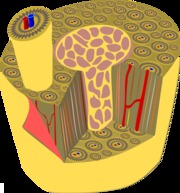Osteonecrosis is the death of bone tissue after reduced blood supply to the tissue. When osteonecrosis attacks bone tissue near a joint, the joint surface may fail, leading to arthritis.
Osteonecrosis most commonly hits the hip, the humerus, knees, clavicle, scapula, and ankles, although any part of the skeleton can be affected. A particular form is osteonecrosis of the jaw, which has different causes and requires different treatments from regular osteonecrosis.
It is estimated that 10,000 to 20,000 patients are diagnosed with osteonecrosis each year in the United States. Experts feel the condition is underdiagnosed. It primarily afflicts people in their 20s, 30s, and 40s. Eight times as many men get it as women./p>
Osteonecrosis occurs when blood flow to a bone is interrupted or reduced. It can be caused by an injury (traumatic) or can occur spontaneously (non-traumatic).
The most common causes of non-traumatic osteonecrosis are long-term use of medications called corticosteroids and long-term alcoholism. Those account for over 95% of cases. Less common causes are: blood disorders, liver disease, radiotherapy, chemotherapy, decompression sickness (which occurs in divers), dialysis, and organ transplants.
Immunosuppressive regimens also lead to osteonecrosis. HIV patients are estimated to have 100 times as high a risk of osteonecrosis as healthy people.
In about 20% of patients the cause remains unknown (idiopathic osteonecrosis). More on risk factors versus causes.
Interestingly, nontraumatic osteonecrosis shows the tendency to symmetry in the human anatomy. When is shows up in one part of the skeleton, it also ends up on the opposite side of the body about 60% of the time.
People who take bisphosphonates — a type of medicine used to treat osteoporosis — sometimes develop osteonecrosis of the jaw. The risk is higher for patients with multiple myeloma, breast, and lung cancers and Paget’s disease of bone, and patients who have received high doses of bisphosphonates intravenously to counteract the damage caused by cancer in the bones.
At early stages osteonecrosis might cause no or mild pain. In later stages, the pain increases gradually, and is accompanied by stiffness and a limitation of motion of the involved joint. Over time the bone is afflicted with an increasing accumulation of tiny fractures. These tiny fractures build up fast in “load-bearing” bones. The hips are particularly vulnerable.
The bone can collapse after the blood supply is compromised. Standing or walking worsens the pain and a limp develops. It is usually a few months to two years from the time of the first symptom to loss of joint function.
Osteonecrosis of the jaw is characterized by pain, soft-tissue swelling and infection, loosening of teeth, exposed bone, and feelings of numbness or heaviness in the jaw.
One clue for doctors is when patients do not correctly heal after fractures. That suggests osteonecrosis. Unexplained pain at common osteonecrosis sites (e.g. hip, knee) can also suggest osteonecrosis if there are risk factors present.
Magnetic resonance imaging (MRI) is considered the best method for diagnosing osteonecrosis because it shows diseased areas that are not yet causing any symptoms.
Bone scans and x-rays are also used. Bone scans are a form of nuclear imaging. A radioactive tracer is injected into the patient’s body. This material accumulates in the parts of the skeleton that are injured or healing, and shows up as bright spots on the imaging plate. A radiologist can see evidence of abnormal bone formation.
X-rays scans look normal at early stages of the disease; only later do bone damage and osteoarthritis become evident on X-ray images. Computed tomography (CT) scans is a type of x-ray imaging that is more precise than traditional X-rays and bone scans, but less sensitive than MRI.
Biopsy of the bone is a conclusive tests, but rarely used as it requires surgery.
The goal in treating osteonecrosis is to improve the patient’s use of the affected joint, stop further damage, and ensure bone and joint survival. Without treatment, patients generally experience severe pain and limitation in movement within two years.
Nonsteroidal anti-inflammatory drugs (NSAIDs), such as aspirin or ibuprofen, relieve pain and inflammation associated with osteonecrosis. NSAIDs are available as over-the-counter products and as prescription medications.
Reducing weight bearing on the affected bones, by using canes, crutches or a walker, may slow the osteonecrosis-induced damage. They can help protect the joint until surgery.
Range-of-motion exercises (a staple of occupational health therapy) help keep the affected joints mobile and effective. Electrical stimulation can stimulate bone growth, either during surgery, applied directly to the damaged area, or through electrodes attached to the skin. This is somewhat of an esoteric treatment, however, and most osteonecrosis patients will not have it. For the osteonecrosis of the jaw, medical options include scraping away the damaged bone, taking antibiotics orally, using mouth rinses and avoiding invasive dental procedures. Typical dental surgery can make osteonecrosis worse.
These nonsurgical treatments relieve pain, but usually are not permanent solutions.
Doctors usually recommend surgery for osteonecrosis. The surgery can be put off for a while, but nonsurgical therapies are not effective enough. There are a number of surgical procedures that slow or stop progression of the disorder. Surgical procedures include:

